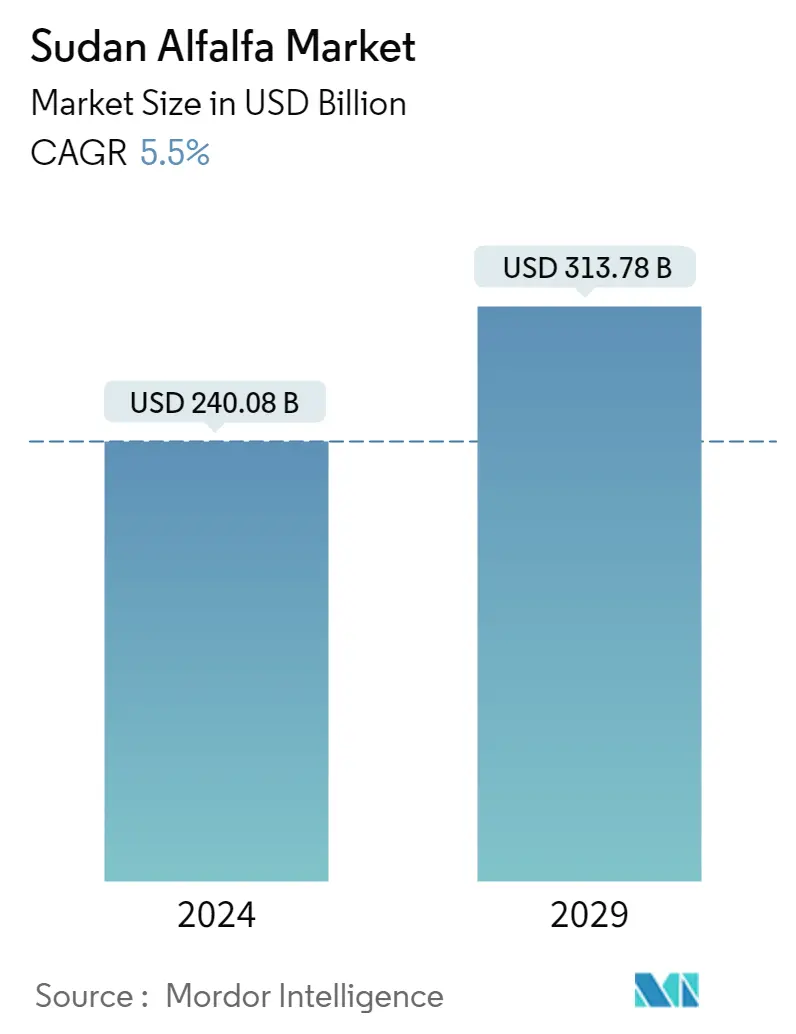Market Size of Sudan Alfalfa Industry

| Study Period | 2019 - 2029 |
| Base Year For Estimation | 2023 |
| Forecast Data Period | 2024 - 2029 |
| Market Size (2024) | USD 240.08 Billion |
| Market Size (2029) | USD 313.78 Billion |
| CAGR (2024 - 2029) | 5.50 % |
Major Players*Disclaimer: Major Players sorted in no particular order |
Sudan Alfalfa Market Analysis
The Sudan Alfalfa Market size is estimated at USD 240.08 billion in 2024, and is expected to reach USD 313.78 billion by 2029, growing at a CAGR of 5.5% during the forecast period (2024-2029).
- Alfalfa is native to warmer temperate climates, widely grown in the Northern and Central parts of the country. Historically, alfalfa was grown by small farmers using river or bore water. Those farmers used surface (canal) irrigation to water the crop. But with the growing demand for the crop, businesses started to irrigate their wide fields through center pivots that now spread widely in the country.
- The major factors influencing the alfalfa hay market include the increasing demand for quality hay for livestock and cattle population, prices of alfalfa hay, and price trends in alternative feed and forage.
- According to various research studies, feeding alfalfa hay enhances the growth and development of animals at a faster rate and improves milk productivity. This increased demand for alfalfa hay, especially for feeding cattle and horses.
- The production of alfalfa in Sudan is showcasing a consistently increasing trend. One of the main driving factors is the increasing investments in the country by various foreign firms, especially from the GCC (Gulf Cooperation Council) countries. Currently, there are no imports of alfalfa into the country. However, the country imports seeds for cultivating alfalfa from other countries, such as Australia, the United States, and the United Arab Emirates.
Sudan Alfalfa Industry Segmentation
Alfalfa is cultivated as an important forage crop in Sudan. It is used for grazing, hay, silage, green manure, and cover crop.
Sudan alfalfa hay market reports provides a detailed analysis by extensively analyzing the production (volume), consumption (value and volume), import (value and volume), export (value and volume), and price trend within the country.
The market sizing has been done in value terms in USD for all the abovementioned segments.
Sudan Alfalfa Market Size Summary
The alfalfa market in Sudan is experiencing significant growth, driven by increasing demand for quality hay to support the livestock and cattle population. Historically cultivated by small farmers using traditional irrigation methods, the sector has evolved with the adoption of advanced irrigation techniques like center pivots, expanding its reach across the Northern and Central regions of the country. The rising demand for alfalfa hay is largely attributed to its benefits in enhancing animal growth and milk productivity. This demand is further bolstered by investments from foreign firms, particularly those from the Gulf Cooperation Council countries, which are contributing to the consistent increase in alfalfa production within Sudan. The country currently relies on imports of alfalfa seeds from nations such as Australia, the United States, and the United Arab Emirates, as it does not import alfalfa itself.
Sudan's alfalfa industry is also supported by its large livestock population, which plays a crucial role in the country's economy. The changing food consumption patterns, influenced by increased income and rural-urban migration, have led to a greater focus on aggregated food items like meat and dairy products. This shift has encouraged some alfalfa producers to venture into dairy farming, aiming to export value-added products to countries such as the United Arab Emirates, Qatar, and Saudi Arabia. The strategic location of Khartoum, with its significant share of forage crop cultivation, has attracted both local and foreign investors to establish large-scale farms, further driving the market's expansion. Initiatives like those by UAE-based companies investing in Sudanese land for forage production highlight the region's potential for increased productivity through improved irrigation practices.
Sudan Alfalfa Market Size - Table of Contents
-
1. MARKET DYNAMICS
-
1.1 Market Overview
-
1.2 Market Drivers
-
1.3 Market Restraints
-
-
2. MARKET SEGMENTATION
-
2.1 Production Analysis
-
2.2 Consumption Analysis (Volume and Value)
-
2.3 Import Analysis (Volume and Value)
-
2.4 Export Analysis (Volume and Value)
-
2.5 Price Trend Analysis
-
Sudan Alfalfa Market Size FAQs
How big is the Sudan Alfalfa Market?
The Sudan Alfalfa Market size is expected to reach USD 240.08 billion in 2024 and grow at a CAGR of 5.5% to reach USD 313.78 billion by 2029.
What is the current Sudan Alfalfa Market size?
In 2024, the Sudan Alfalfa Market size is expected to reach USD 240.08 billion.

